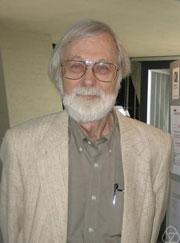Published online 23 March 2011 | Nature | doi:10.1038/news.2011.182
News
Maths polymath scoops Abel award
John Milnor wins 'Nobel of maths' for his manifold works.
 John Milnor, now 80, has contributed to fields from geometry to number theory.G.-M. Greuel/Wikipedia
John Milnor, now 80, has contributed to fields from geometry to number theory.G.-M. Greuel/WikipediaIn retrospect, giving Albert Einstein a Nobel prize for his work on the photoelectric effect looks like an arbitrary choice from among all of his contributions to physics.
In granting the 2011 Abel Prize in mathematics to John Milnor of Stony Brook University in New York, the committee of the Norwegian Academy of Science and Letters has wisely avoided singling out a particular achievement. The citation states merely that Milnor has made "pioneering discoveries in topology, geometry and algebra". In effect, this is a recognition that he has contributed to maths across the board.
In fact, Milnor's work goes further: it also touches on dynamical systems, game theory, group theory and number theory. In awarding this equivalent of a Nobel prize, worth about US$1 million, the committee states that: "All of Milnor's works display marks of great research: profound insights, vivid imagination, elements of surprise, and supreme beauty."
Milnor's breadth is unusual, says Ragni Piene, a mathematician at the University of Oslo who chairs the Abel committee. "Though some of the fields he has worked in are related, he really has had to learn and develop new tools and new theory."
Milnor "says he is mainly a problem solver", adds Piene. "But in the solving process, in order to understand the problem deeply he ends up creating new theories and opening up new fields."
Exotic spheres
Among the most surprising of Milnor's discoveries was the existence of 'exotic spheres' — multidimensional objects with strange topological properties. In 1956, Milnor was studying the topological transformations of smooth-contoured high-dimensional shapes — that is, shapes with no sharp edges. A 'continuous topological transformation' converts one object smoothly — as though remoulding soft clay — into another, without any tears in the fabric.
He discovered that in seven dimensions there exist smooth objects that can be converted into the seven-dimensional equivalent of spheres only via intermediates with sharp kinks.
These exotic spheres can exist in other dimensions. With the French mathematician Michel Kervaire, Milnor calculated that there are 28 exotic spheres in 7 dimensions. But there seems little rhyme or reason to the trend for other dimensions: there is one exotic sphere in 1, 2, 3, 5 and 6 dimensions, 992 in 11 dimensions, 1 in 12 dimensions, 16,256 in 15, and 2 in 16. No one has figured out how many there are in four dimensions. This work spawned an entire new field of mathematics, called differential topology.
Some of Milnor's other achievements are related to similar topological conundrums, such as his work on the relationships between different triangulations (representations as networks of triangles) of mathematical surfaces called manifolds. Topology was also central to some of Milnor's earliest work in 1950 on the curvature of knots.
Trajectory of awards
Milnor's work on group theory is quite different. Group theory was partly invented by the nineteenth-century Norwegian mathematician Niels Henrik Abel, after whom the award is named. In the formulation developed by Abel, a group can be represented as all non-equivalent combinations ('words') of a set of symbols. Milnor and the Czech mathematician Frantisek Wolf clarified how the number of words grows as the number of symbols increases for a wide class of groups called solvable groups.
More recently, Milnor, now 80, has been working in the field of holomorphic dynamics, which concerns the patterns made when the same equation is performed time and again with different inputs. This branch of maths led to the discovery of fractal patterns such as the Mandelbrot and Julia sets.
Milnor has already won just about every other key prize in mathematics, including the Fields Medal (1962) and the Wolf prize (1989). Aside from his skills as a researcher, Milnor has been widely praised as a communicator. His books "have become legendary", says mathematician Timothy Gowers of the University of Cambridge, UK.
Comments
If you find something abusive or inappropriate or which does not otherwise comply with our Terms or Community Guidelines, please select the relevant 'Report this comment' link.
Comments on this thread are vetted after posting.
There are currently no comments.
Add your own comment
This is a public forum. Please keep to our Community Guidelines. You can be controversial, but please don't get personal or offensive and do keep it brief. Remember our threads are for feedback and discussion - not for publishing papers, press releases or advertisements.
You need to be registered with Nature to leave a comment. Please log in or register as a new user. You will be re-directed back to this page.

Nenhum comentário :
Postar um comentário